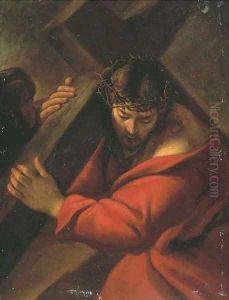Sisto Badolocchio Paintings
Sisto Badalocchio Rosa, born in Parma in 1585, was an Italian painter and engraver associated with the Baroque movement. His artistic journey began under the tutelage of Annibale Carracci at his academy in Bologna, where he honed his skills and adopted Carracci's style, which focused on classical harmony and balance in composition. Badalocchio was known for his collaboration with other artists, most notably with Giovanni Lanfranco, with whom he worked on the frescoes in the San Giovanni Evangelista in Parma.
Badalocchio's contributions to art history are significant due to his role in the development of the quadratura—a style of ceiling painting in which architectural elements are painted to appear as if they are extending the real architecture of the room into an imaginary space. His work in the Palazzo Farnese in Rome, alongside Carracci and Lanfranco, is a prime example of this technique. He also worked in the Palazzo Costaguti and the church of Santa Maria della Vittoria in Rome.
In addition to his frescoes, Badalocchio was also an accomplished engraver. He and Lanfranco produced a series of engravings after Raphael's paintings in the Vatican, called 'Raphael's Bible,' which helped disseminate the High Renaissance style throughout Italy and beyond. These engravings were crucial for the spread of Raphael's compositional techniques and were widely studied by artists and connoisseurs.
Unfortunately, Badalocchio's career was relatively short, and there is a scarcity of documented works after 1620. The exact date of his death is uncertain, with some sources suggesting that he may have lived until the 1640s, but there is little evidence to support this. Sisto Badalocchio's legacy lives on through his contributions to the art of fresco painting, his involvement in the spread of the Carracci stylistic influence, and his engravings that propagated the works of Raphael.
